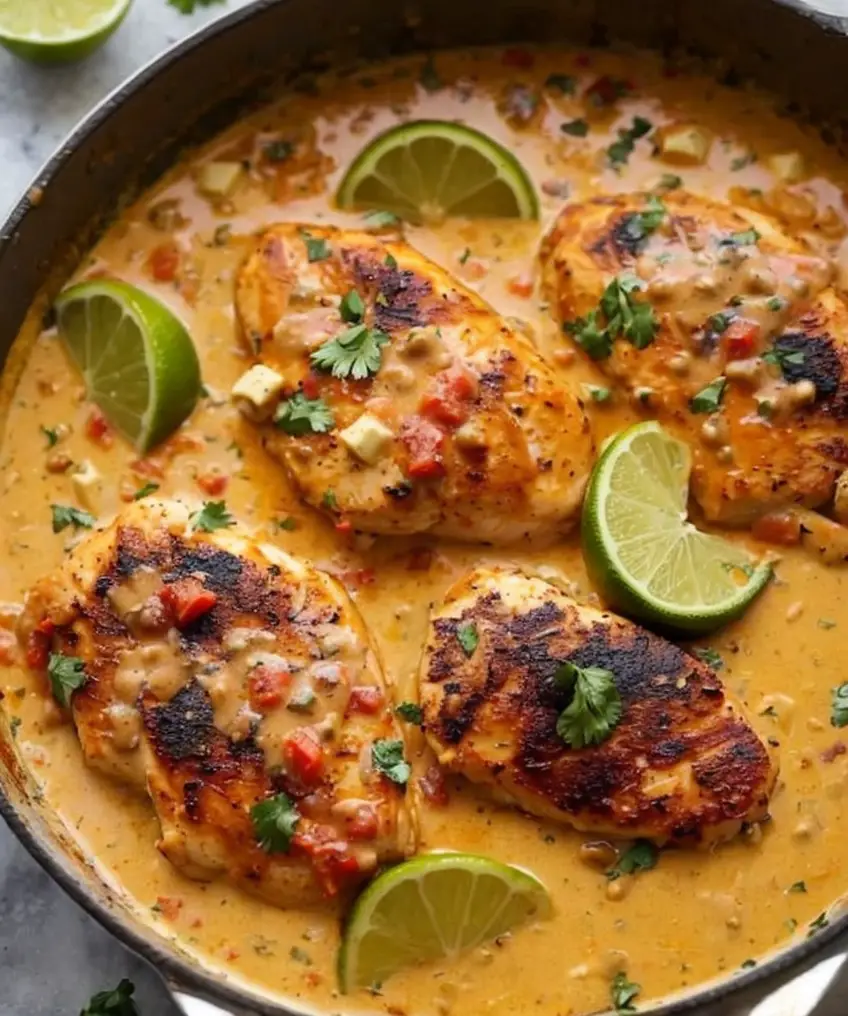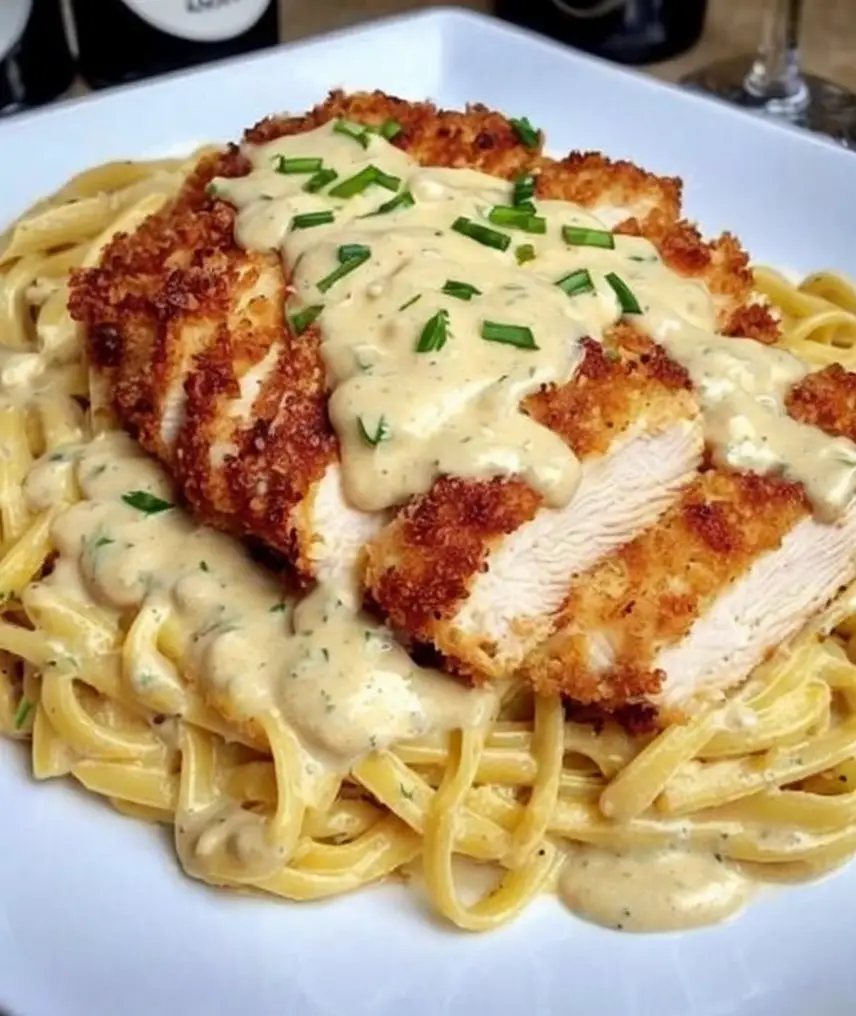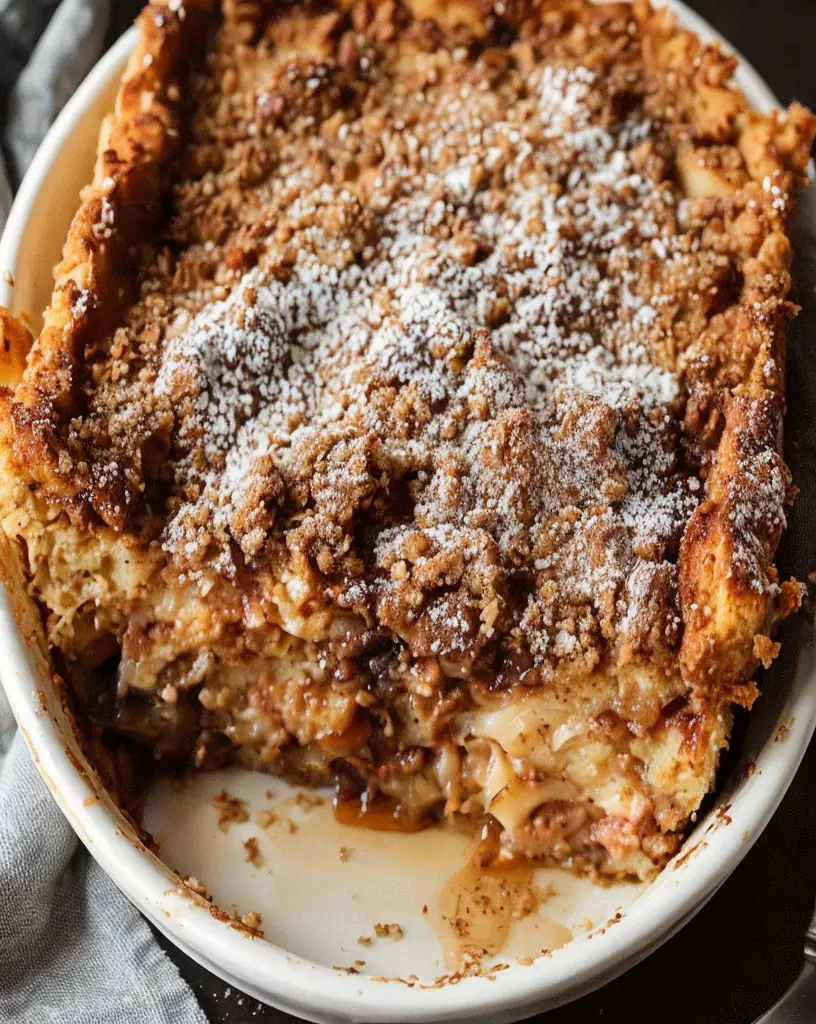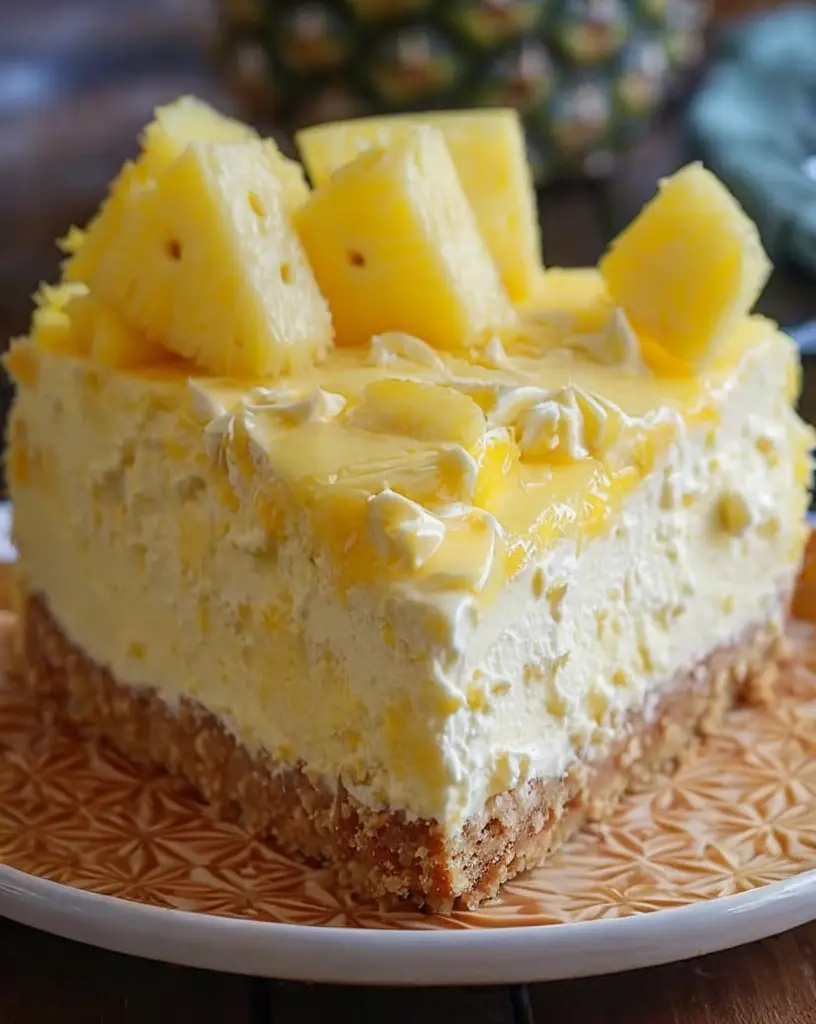Cajun Lime Chicken with Creamy Tomato Sauce: A Flavorful Delight
This Cajun Lime Chicken with Creamy Tomato Sauce is a delightful dish that brings together the vibrant flavors of Cajun spices and the fresh zing of lime, all embraced by a rich and creamy tomato sauce. Imagine tender chicken marinated in a blend of spices, seared to perfection, and then bathed in a luscious sauce that tantalizes the taste buds. This recipe not only packs a punch in flavor but also makes for an eye-catching presentation on your dining table, ensuring that it becomes a favorite among family and guests alike.
The combination of spices creates a robust flavor that is balanced beautifully by the creamy tomato sauce, while the lime adds a refreshing burst that elevates the dish. As you savor each bite, you’ll appreciate how the multiple layers of taste intertwine, providing a satisfying texture that complements the tender chicken. Perfect for a weeknight dinner or entertaining friends, this dish invites warmth and enjoyment.
Quick Recipe Highlights
- Flavor Profile: The Cajun spices offer a bold, peppery kick balanced with the tangy brightness of the lime.
- Texture: Juicy chicken enveloped in a silky cream sauce, creating a delightful contrast of textures.
- Aroma: The aromatic blend of Cajun spices and zesty citrus makes this dish irresistible.
- Visual Appeal: A vibrant mix of colors from the creamy red sauce and golden-brown chicken creates a feast for the eyes.
- Skill Level Needed: This recipe requires basic cooking skills, perfect for both novice and experienced cooks.
- Special Equipment: A large skillet or sauté pan is essential for cooking the chicken and sauce.
Recipe Overview
- Difficulty Level: This recipe is rated medium due to the need for proper cooking techniques to achieve perfect chicken and sauce consistency.
- Category: It can be classified as a main dish, ideal for lunch or dinner.
- Cuisine: Cajun cuisine is characterized by its rich and flavorful profiles, influenced by French, African, and Native American culinary traditions.
- Cost: The ingredients are relatively inexpensive, making it an accessible option for meals without compromising on taste.
- Season: This dish is suitable year-round, but it shines especially in spring when fresh limes are at their best.
- Occasion: It’s perfect for family gatherings, casual dinner parties, or even a cozy date night at home.
Why You’ll Love This Recipe
The taste of Cajun Lime Chicken with Creamy Tomato Sauce is an adventure for your palate. The Cajun spice mix creates a flavorful base that enhances the chicken, while the creamy tomato sauce adds a luxurious, comforting element. The brightness of lime introduces an unexpected twist, making this dish not only appetizing but also refreshing.
Preparation is a breeze! The marinade can be prepared in advance, allowing the chicken to soak up the flavors. During cooking, you can multitask by preparing sides, making this recipe ideal for a quick weeknight meal or an elaborate dinner. With minimal cleanup needed, you’ll have more time to relax and enjoy your creation.
Nutritionally, this dish strikes a good balance. The chicken provides lean protein while the tomatoes are rich in antioxidants, particularly lycopene. This meal can be complemented with a variety of veggies or served over whole grains to enhance its health benefits further.
Cajun Lime Chicken is not just a meal; it’s an experience. It invites conversation and shared enjoyment around the dining table, perfect for celebrations or casual family dinners alike. Guests will appreciate the effort you put into creating such a delicious dish.
Lastly, this recipe is cost-effective. Using readily available ingredients from your pantry, you can whip up a restaurant-quality meal without breaking the bank. Its accessibility in terms of ingredients and preparation makes it a go-to dish for any home cook.
Historical Background and Cultural Significance
The origins of Cajun cuisine stem from the Acadians, French settlers who adapted their cooking methods to the ingredients available in the rural South. This blending of cultures created a unique and flavorful cuisine representing Louisiana’s rich heritage. Cajun dishes often reflect a history of resourcefulness, utilizing what was available in local markets and reflecting the community’s agricultural roots.
Cajun cooking holds cultural significance in Louisiana, where food is a central element of communal gatherings and celebrations. Dishes like Cajun Lime Chicken showcase the blending of ingredients and techniques passed down through generations. Because of this deep-rooted cultural history, Cajun cuisine is celebrated for its bold flavors and heartwarming traditions.
Over time, Cajun cooking has evolved and adapted, influenced by various culinary traditions including Creole, French, and Southern cooking. As a result, modern Cajun recipes, such as this chicken dish, showcase innovation while respecting their traditional roots.
Regional variations can also be seen, with different areas of Louisiana featuring their own twists on classic Cajun dishes. In some areas, a spicier blend of seasonings is favored, while others may incorporate seasonal vegetables or alternative proteins, showcasing the diversity within Cajun cooking.
Ingredient Deep Dive
Chicken: Chicken, particularly breast meat, is the star of this dish. It’s a lean protein, versatile in cooking, and absorbs flavors beautifully. When choosing chicken, look for fresh, organic options for the best taste and texture. Store raw chicken in the fridge and consume it within a couple of days or freeze it for later use. If you’re looking for a substitution, turkey breast can serve as a nice alternative.
Cajun Spices: The Cajun spice blend typically includes paprika, cayenne pepper, garlic powder, and onion powder. These spices not only add flavor but also bring warmth and depth to the dish. Each blend may vary based on the chef’s preference, but selecting fresh spices will enhance the overall taste. Store spices in a cool, dark place to maintain their potency, and consider making your own blend for a personal touch.
Tomatoes: Tomatoes, whether canned or fresh, form the base of the creamy sauce. They are rich in antioxidants, particularly lycopene, and provide a sweet yet tangy flavor profile. When selecting tomatoes, fresh options should feel firm and vibrant, while canned varieties should have minimal additives. Store tomatoes in a cool place, and once opened, canned tomatoes should be refrigerated and consumed within a week.
Heavy Cream: Heavy cream is used to create a luscious, creamy texture in the sauce. It adds richness and helps balance the spice levels. Always choose fresh cream with a high fat content for the best results. Store in the refrigerator and be mindful of expiration dates. For a lighter alternative, half-and-half can work, but it will yield a less rich sauce.
Common Mistakes to Avoid
- Overcooking the chicken: This can lead to dry and tough meat. Use a meat thermometer to ensure doneness, aiming for an internal temperature of 165°F.
- Using stale spices: Old spices can diminish the flavor. Always check your spice’s freshness for optimal taste.
- Cooking on high heat without control: This can cause uneven cooking and burning. Use medium heat to ensure the chicken cooks through without charring.
- Neglecting to marinate: Skipping the marinade reduces the flavor depth. Allow the chicken to marinate for at least 30 minutes, or overnight for even better infusion.
- Rushing the sauce: A good sauce needs time to develop its flavors. Allow it to simmer gently, which helps meld the spices with the cream.
- Not adjusting seasoning: Always taste your sauce before serving. A splash of lime or dash of salt can elevate flavors significantly.
- Incorrect ingredient ratios: Following the recipe is crucial for balance. Adjusting ratios can lead to overpowering flavors.
- Skipping garnishes: Simple garnishes like fresh herbs can brighten the dish and enhance presentation. Don’t skip this final touch!
Essential Techniques
Marinating Chicken: Marinating is crucial for infusing flavors into the chicken. Use acid-based marinades (like lime juice) to tenderize the meat. Ensure the chicken sits in the marinade for at least 30 minutes, or even longer if possible, to maximize flavor penetration.
Creating a Sauce: A good sauce involves constructing layers of flavor. Start by sautéing aromatics, then adding your liquid components. Allow it to simmer for a while to reduce and concentrate flavors. Pay attention to the consistency; a perfect sauce should coat the back of a spoon.
Sealing in Juices: Searing the chicken helps develop a crispy exterior while locking in juices. Ensure the skillet is hot before adding the meat, allowing a proper sear to form before flipping. This technique enhances both flavor and texture.
Pro Tips for Perfect Cajun Lime Chicken
1. Use fresh herbs like cilantro or parsley as a garnish, adding a fresh finish to the dish.
2. Adjust the amount of cayenne pepper based on your heat preference; start small and add more if desired.
3. For a smoky flavor, consider adding some smoked paprika to your spice blend.
4. Pair with a side of cornbread or rice to soak up the delicious sauce.
5. Let the dish sit for a few minutes after cooking to allow the juices to redistribute before serving.
6. Experiment with adding other vegetables to the sauce, such as bell peppers or spinach, for added nutrition.
7. Always taste and adjust seasonings throughout the cooking process to get the perfect balance.
8. For presentation, slice the chicken before serving, showcasing the juicy interior against the creamy sauce.
Variations and Adaptations
For a regional twist, consider incorporating local ingredients. Swap out traditional Cajun spices for a spicier blend if you crave more heat, or try adding some diced chorizo to the sauce for a unique taste.
Seasonal adaptations can include freshly diced tomatoes instead of canned ones when they are in-season, enhancing the dish’s brightness and flavor.
For those on dietary modifications, replacing heavy cream with coconut milk creates a dairy-free version while adding a subtle sweetness. Similarly, using zoodles or cauliflower rice can offer low-carb options.
Flavor variations might also arise by introducing additional herbs and spices, like basil or oregano, for a new aromatic profile, while texture modifications could include blending the sauce for a smooth finish or leaving it chunky.
Presentation alternatives can elevate the dish with unique plating techniques—serve in bowls or on rustic plates, and top with grilled lime halves for a vibrant visual touch.
Serving and Presentation Guide
Plating this dish beautifully can enhance the dining experience. Use a large white plate to contrast the bright colors of the chicken and sauce. Pour the sauce over the chicken and use a spoon to ensure even coverage, showcasing the creamy texture.
Garnishing adds a lively element; sprinkle freshly chopped herbs like cilantro or fresh lime zest just before serving.
Traditional accompaniments include rice or cornbread, creating a wholesome meal, while modern suggestions can involve serving over a bed of spiralized vegetables for a low-carb option.
Ensure the dish is served warm, as creamy sauces can lose their luster if allowed to cool. Use a ladle to control portion sizes when plating, keeping servings even and visually appealing.
Wine and Beverage Pairing
For wine pairings, a chilled Sauvignon Blanc complements the dish beautifully, as its citrus notes highlight the lime while balancing the richness of the sauce. Alternatively, a light-bodied red, such as Pinot Noir, can offer a nice contrast to the spiced chicken.
Non-alcoholic options include sparkling water with lime or citrus-infused iced tea, providing refreshing contrasts while echoing the dish’s main ingredient.
If enjoying coffee or tea, a mild herbal tea or dark roast coffee will not overpower the flavors and could provide a comforting finish to the meal.
Storage and Shelf Life
To store leftovers, allow the dish to cool completely before placing it in an airtight container. Keep in the fridge and consume within 3-4 days for optimal freshness. For long-term storage, freezing is an option; just ensure it’s in a sealable freezer-safe container.
When reheating, use gentle heat on the stovetop or microwave to prevent the chicken from drying out. Adding a splash of cream or broth during reheating can help retain moisture.
Check for signs of spoilage, such as off-smells or changes in texture, before consuming leftovers. Freezing guidelines suggest consuming within 2-3 months for best quality.
Make Ahead Strategies
You can prepare Cajun Lime Chicken in stages. Marinate the chicken up to 24 hours in advance to allow flavors to deepen.
Consider prepping the sauce independently; it can be made and stored in the fridge for a couple of days before serving.
For assembly, keep the cooked chicken and sauce separate, combining them just before serving for optimal freshness.
Reheating should be done gently to maintain the dish’s integrity, with fresh lime garnishes added just before serving to enhance flavor brightness.
Scaling Instructions
If you wish to halve the recipe, simply reduce all ingredient measurements by 50%, ensuring even flavors.
For doubling or tripling the dish, consider the size of your cooking equipment to avoid overcrowding, which can lead to uneven cooking.
Timing may vary with larger batches—extend cooking time as needed, observing visual cues for doneness.
Ensure storage containers are adequate based on batch size; larger batches may require stacking or multi-level storage solutions to maintain freshness.
Nutritional Deep Dive
From a nutritional perspective, this dish offers a well-rounded meal, rich in protein due to the chicken content. Each serving provides essential nutrients like B vitamins and iron beneficial for overall energy levels.
Micronutrient analysis can reveal the benefits of tomatoes, which contain vitamins A and C, contributing to immune health and skin vitality.
As for dietary considerations, this dish can be adjusted to suit various dietary patterns without losing its essence. Balancing portion sizes helps with weight management while ensuring all important food groups are included.
For those tracking macros, the protein content from chicken is significant, while the creamy sauce adds some fats; consider making adjustments based on dietary goals for a perfect fit.
Dietary Adaptations
With an eye on dietary needs, this Cajun Lime Chicken can easily be made gluten-free by confirming all ingredients are certified gluten-free.
A dairy-free version can be achieved by substituting heavy cream with coconut milk or vegan cream alternatives, while ensuring flavor remains robust.
For those opting for a vegan meal, consider using a plant-based protein such as grilled tofu or tempeh marinated in cajun spices for the same flavor profile.
Those looking for low-carb or keto options can simply skip rice and serve on a bed of spiralized zucchini instead.
Troubleshooting Guide
If you encounter texture issues with your chicken—perhaps it’s too tough—try reducing your cooking time or brining it beforehand to keep it moist. If over-seasoned, balance with a touch of cream or sugar to temper the flavors.
Flavor balance can vary; if the dish tastes too flat, consider adding a touch more acid with lime juice or adjusting spices toward the end of cooking.
Temperature problems may arise if the skillet isn’t adequately heated; preheating is essential for searing the chicken correctly.
If you run into equipment challenges, using a meat thermometer can prevent overcooking while ensuring chicken is cooked through.
For ingredient substitutions, be mindful of how flavors balance; for instance, switching out heavy cream may alter the sauce’s richness.
Timing concerns can often be resolved with careful preparation; having all ingredients ready at the start minimizes delays throughout the cooking process.
Recipe Success Stories
Numerous cooks have shared feedback on how this dish has become a highlight at their gatherings. The vibrant flavors and impressive presentation have garnered rave reviews, with many expressing their delight at replicating such a flavorful dish at home.
Variations have emerged, with readers experimenting with different spice blends or adding seasonal vegetables, showcasing the dish’s versatility. Adaptation stories often highlight how easily the recipe echoes personal tastes and preferences, further personalizing the experience.
Photography tips share how a well-styled plate draws viewers to the deliciousness, with many home cooks enjoying showcasing their culinary creations on social media.
Reader suggestions include pairing options or additional side dishes that pair well, creating a more rounded meal experience for potential new cooks eager to try this recipe.
Frequently Asked Questions
A: Absolutely! Chicken thighs will add more moisture and flavor, although the cooking time may need adjustment due to their richer fat content.
Q: Is this recipe spicy?
A: The Cajun spices provide a kick, but you can adjust the cayenne pepper to suit your preferred spice level.
Q: Can I make this dish in advance?
A: Yes! Prepare the chicken and sauce ahead of time and reheat just before serving. It also tastes great the next day!
Q: What can I serve with this dish?
A: Serve with rice, mashed potatoes, or crusty bread to soak up the delicious sauce. A fresh salad would also complement the meal.
Q: How do I know when the chicken is cooked through?
A: Ensure the internal temperature reaches 165°F. Using a meat thermometer is the most reliable way to check doneness.
Q: Can I freeze leftovers?
A: Yes, you can freeze the chicken and sauce in an airtight container for up to three months. Just reheat thoroughly before serving.
Q: How do I store leftovers?
A: Allow it to cool, then store in an airtight container in the fridge for 3-4 days, or freeze for longer storage options.
Q: Can I substitute heavy cream?
A: Yes! You can use coconut milk or a plant-based cream for a lighter, dairy-free version.
Q: What other meats can I use?
A: You can substitute chicken with turkey, pork, or even shrimp, adjusting cooking times accordingly for different proteins.
Q: Is this a traditional Cajun dish?
A: While it incorporates Cajun flavors, this specific recipe has modern influences and can be adapted to various tastes.
Additional Resources
If you enjoyed this recipe and are looking for related options, consider exploring other Cajun-inspired dishes or techniques. For those interested in deepening their culinary skills, we recommend looking into basic knife skills, spice blending methods, and other sauce-making techniques.
Equipment recommendations include a quality skillet, food thermometer, and good-quality knives, essential for achieving the best results when preparing meals in the kitchen.
Don’t forget to explore seasonal variations to enjoy the freshest flavors available, adapting to what’s in season near you.
Join the Conversation
We invite you to share your experiences with this recipe! Whether it’s through social media or our blog comments, we love hearing about your culinary adventures.
Photography tips for sharing your dish include bright lighting and ample garnishing, which can elevate the visual appeal of your meal online.
Your recipe reviews help foster community engagement and inspire others to try it out. We encourage you to share any variations or twists you put on this classic dish—your creativity is welcome in our kitchen!
The Recipe
Cajun Lime Chicken
Serves: 4
Prep Time: 15 mins
Cook Time: 30 mins
Total Time: 45 mins
Kitchen Equipment Needed
- Large skillet or sauté pan
- Meat thermometer
- Mixing bowl
- Whisk
- Cutting board
- Knife
Ingredients
- 4 boneless, skinless chicken breasts
- 1 tablespoon Cajun seasoning
- 2 tablespoons olive oil
- 1 cup heavy cream
- 1 can (14.5 oz) diced tomatoes
- 2 limes, juiced and zested
- Salt and pepper to taste
- Fresh cilantro for garnish
Directions
- In a mixing bowl, combine chicken breasts, Cajun seasoning, lime juice, and some zest. Marinate for at least 30 minutes.
- In a large skillet, heat olive oil over medium heat. Add the marinated chicken and cook until golden brown, about 6-7 minutes on each side.
- Remove the chicken from the skillet and set aside. In the same skillet, add diced tomatoes and heavy cream, stirring until combined.
- Let the mixture simmer for 5 minutes, then return chicken to the skillet, coating it in the sauce. Cook an additional 5 minutes.
- Adjust seasoning with salt and pepper. Remove from heat and top with fresh lime zest and cilantro before serving.
Recipe Notes
- For a lighter sauce, substitute heavy cream with Greek yogurt or coconut milk.
- Feel free to add vegetables such as spinach or bell peppers to the sauce for an extra nutritional boost.
- This dish pairs well with rice, quinoa, or bread for dipping.
- Leftovers can be stored in an airtight container in the fridge for up to 4 days.




